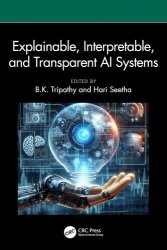 Название
Название: Explainable, Interpretable, and Transparent AI Systems
Автор: B.K. Tripathy, Hari Seetha
Издательство: CRC Press
Год: 2025
Страниц: 355
Язык: английский
Формат: pdf (true)
Размер: 29.6 MB
Transparent Artificial Intelligence Systems facilitate understanding the decision-making process and provide opportunities in various aspects of providing explainability of AI models. This book provides up-to-date information on latest advancements in the field of Explainable AI, which is the critical requirement of AI/ML/DL models. It provides examples, case studies, latest techniques, and applications from the domains of health care, finance, network security etc. It also covers open-source interpretable tool kits such that practitioners can use them in their domains. There is an imminent need for explainable AI (XAI) techniques that are accountable, fair, transparent, and trustworthy without compromising the performance of the models, which would lead to better interaction with machines by users. It becomes essential to explain why and how decisions are made by machines. Machine Learning models must have the ability to provide reasoning, describe their merits and demerits, and convey an understanding of how they will behave. To achieve this, new or modified machine‑learning techniques that provide the required explanations must be developed. These models, in combination with human‑computer interface techniques, must be able to provide users with a greater understanding of why, how, and when a machine model or a deep learning model will perform well. It is important for any business to understand the process used to make decisions by AI models. Transparent AI systems facilitate understanding of the decision‑making process and also provide opportunities in various aspects of explaining AI models. Under the above background, this book aims to provide readers with up‑to‑date information on the latest advancements in the field of explainable AI, which is a critical requirement of AI, Machine Learning (ML), or Deep Learning (DL) models.







 Название: MagPi
Название: MagPi
